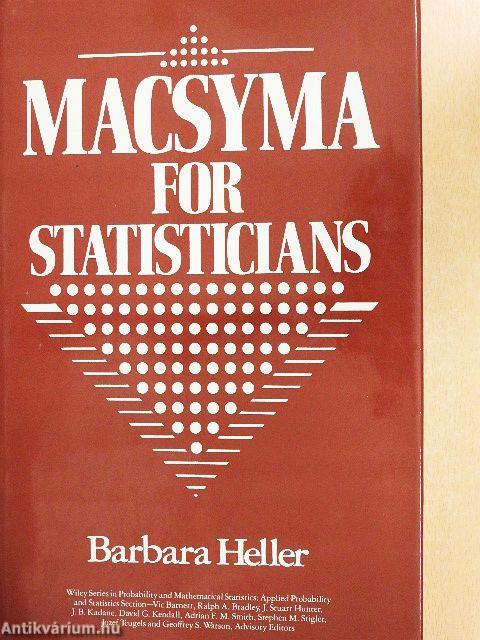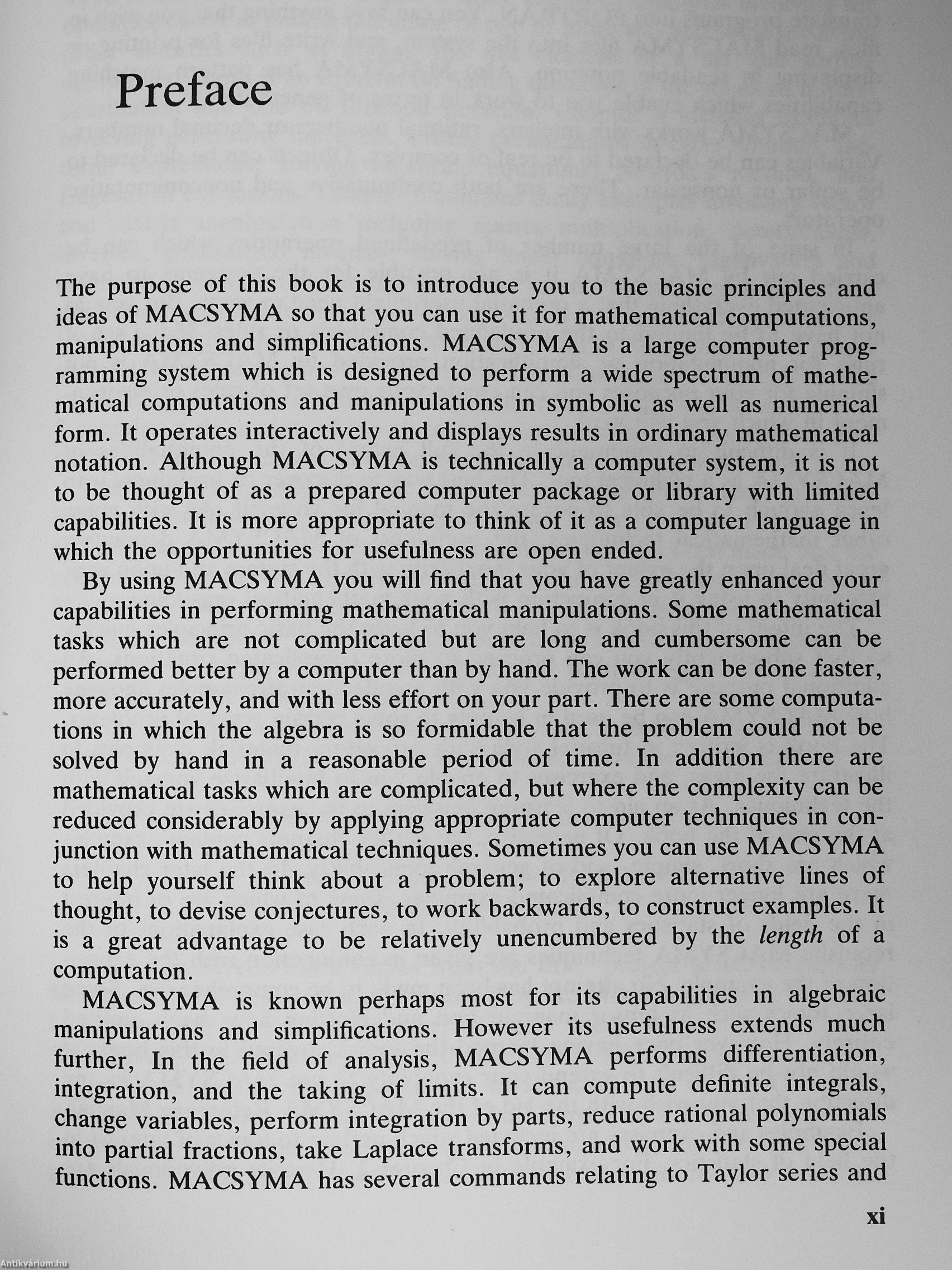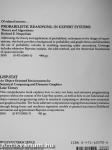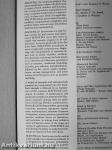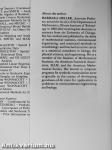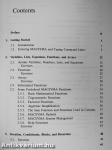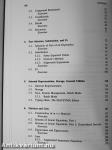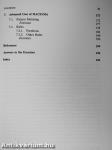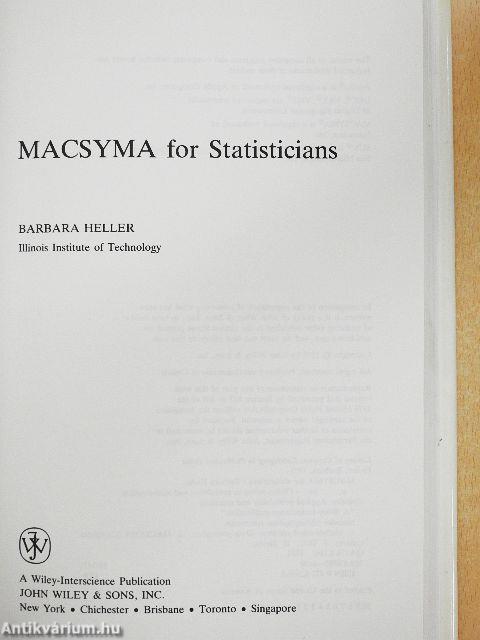1.104.039
kiadvánnyal nyújtjuk Magyarország legnagyobb antikvár könyv-kínálatát

VISSZA
A TETEJÉRE
JAVASLATOKÉszre-
vételek
MACSYMA for Statisticians
| Kiadó: | Wiley-Interscience Publication-John Wiley & Sons, Inc. |
|---|---|
| Kiadás helye: | New York |
| Kiadás éve: | |
| Kötés típusa: | Vászon |
| Oldalszám: | 246 oldal |
| Sorozatcím: | |
| Kötetszám: | |
| Nyelv: | Angol |
| Méret: | 24 cm x 16 cm |
| ISBN: | 0-471-62590-6 |
naponta értesítjük a beérkező friss
kiadványokról
naponta értesítjük a beérkező friss
kiadványokról
Előszó
TovábbFülszöveg
Of related interest
PROBABILISTIC REASONING IN EXPERT SYSTEMS
Theory and Algorithms Richard E. Neapolitan
Addressing the theory and application of probabilistic techniques in the design of expert systems, this book provides a background in probability and graph theory and illustrates the use of probability calculus in modeling reasoning under uncertainty. Coverage includes subjective Bayesian analysis, the odds method, and the theoretical foundations of causal networks.
1990 (0 471-61840-3) 448 pp.
LISP-STAT
An Object-Oriented Environment for Statistical Computing and Dynamic Graphics Luke Tierney
This comprehensive book explains how to carry out basic and extensive programming projects within the context of the Lisp-Stat system, as well as how to use functional and object-oriented programming styles in statistical computing to develop new numerical and graphical models. The book addresses computations ranging from summary statistics through fitting linear and nonlinear... Tovább
Fülszöveg
Of related interest
PROBABILISTIC REASONING IN EXPERT SYSTEMS
Theory and Algorithms Richard E. Neapolitan
Addressing the theory and application of probabilistic techniques in the design of expert systems, this book provides a background in probability and graph theory and illustrates the use of probability calculus in modeling reasoning under uncertainty. Coverage includes subjective Bayesian analysis, the odds method, and the theoretical foundations of causal networks.
1990 (0 471-61840-3) 448 pp.
LISP-STAT
An Object-Oriented Environment for Statistical Computing and Dynamic Graphics Luke Tierney
This comprehensive book explains how to carry out basic and extensive programming projects within the context of the Lisp-Stat system, as well as how to use functional and object-oriented programming styles in statistical computing to develop new numerical and graphical models. The book addresses computations ranging from summary statistics through fitting linear and nonlinear regression models to general maximum likelihood estimation and approximate Bayesian computations. 1990 (0 471-50916-7) 416 pp.
WILEY-INTERSCIENCE ISBN D-MVl-bESTG-b
ProL'iond^Refoe^^^^^ Trade Group III lllll II lllllll llllllllllll ,.?.,°i°ii?ii°i
MACSYMA, the computer program that allows mathematical tasks to be performed in terms of both numbers and formulas, has revolutionized the manipulation of large, complex mathematical computations. In those cases where it is applicable, MACSYMA allows users to move beyond a problem's computational complexity and perform faster, more accurate, less tedious mathematical manipulations.
MACSYMA for Statisticians is a step-by-step tutorial for both novice and experienced MACSYMA users who want to exploit this versatile program to its full potential. It moves gradually from the most basic MACSYMA procedures to more complicated computations. Beginning with manipulations of essential objects such as atomic variables, numbers, lists, functions, and arrays, the book moves on to describe and illustrate operations such as iteration, conditional branching, recursion, part selection, and substitution, followed by list, vector, matrix manipulation, storage management, and some advanced techniques such as pattern matching.
A wealth of examples and exercises (with answers) are incorporated into the book. Each example is followed by an explanation of the requisite MACSYMA techniques. A number of mathematical and statistical examples are presented for illustrative purposes. Among these are problems involving Hermite polynomials, Bernoulli and Stirling numbers, generating functions, moments, asymptotic expansions, maximizations, solutions of systems of equations, matrix inversion, generalized inverses, quadratic forms, set operations, and partitions. In solving these problems users will become aware of the range and variety of applications of MACSYMA and will develop the ability to apply these techniques in contexts of their own choice.
MACSYMA for Statisticians can be used as a self-tutorial or as a classroom textbook. It is designed for statisticians, probabilists, mathematicians and students in universities, and those in government and industry.
HART AND SAMUEL S. WILKS
'tuart Hunter,
ill, Adrian F. M. Smith,
¦, Geojfrey S. Watson
Ids
; Time Series
/ariate Statistical Analysis,
s and Multivariate Analysis rence, Second Edition tistical Concepts and Theory statistical Concepts and Methods e. Second Edition )ueuing Theory Combinatorial Theory
ol for Stochastic Systems
)bservational Studies and Statistical Design
athematical Statistics
ar Space Approach
:s: Characterization and Convergei
ty Theory and Its Applications, ^
id Edition
ne Series
itistics and Their Applications befc
overage Processes
N, and STAHEL • Robust Stati
ical Theory of Linear Systems atistics, Fifth Edition
jroach to Statistics nd Applications
Statistics: Principles and Methoc ory
heory and Statistical Inference,
ises. Second Edition n
Infinitely Divisible Point Process !tatistical Theory ims, Belief Nets and Decision Am Vlodels, and Applications Is in General Linear Models Is in Multivariate Analysis ew Perspectives in Theoretical aj
to the Theory of Nonparametric )
nd Statistics (Continued} ,T, and SMITH • Analy he Algebra of Random tiple Criteria Optimizati iparison Methods for Q )ALL, and MECKE • ! Empirical Model Buildii ;P-STAT: An Object-Or raphics
tic Modeling and Analy >1, SMITH, and MAK
^GLETON • Spatial I antitative Data INGLETON • Spatial Directional Data (RSEL and DE LEEUA Analysis
pplied Linear Regressi< :imization Over Time: I 'olume 11
:ems in Stochastic Equi Sampler on Sampling nd WONNACOTT • 1 nd WONNACOTT • 1 and WONNACOTT d Edition
atistica! Methods for th
About the author
BARBARA HELLER, Associate Professor, joined the faculty of the Department of Mathematics, Illinois Institute of Technology in 1980 after receiving her doctorate in statistics from the University of Chicago. She has worked and published in the fields of mathematical statistics, environmental engineering, and statistical methods in neurobiology and has had an active career as a statistical consultant in biology, the physical sciences, and engineering. She is a member of the Institute of Mathematical Statistics, the American Statistical Association, SIAM, and the American Mathematical Society. Her interest in computer programs for symbolic manipulation arose originally in the course of developing goodness-of-fit tests for application to problems in environmental engineering and biology.
and Statistics ^N • Combinatorial In FENBURG • Predicti( Convergence of Prob< ibility and Stochastic N • Prior Information in Vissza
Témakörök
- Idegennyelv > Idegennyelvű könyvek > Angol > Műszaki
- Idegennyelv > Idegennyelvű könyvek > Angol > Természettudományok > Matematika
- Műszaki > Informatika > Számítógép > Alkalmazása
- Természettudomány > Matematika > Algoritmus, gráf
- Természettudomány > Matematika > Idegennyelvű
- Természettudomány > Matematika > Társtudományok > Műszaki
- Természettudomány > Matematika > Valószínűségszámítás
- Műszaki > Idegennyelv > Angol



